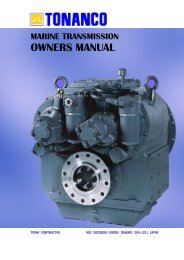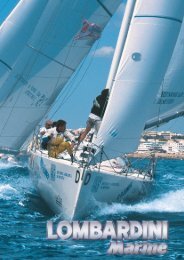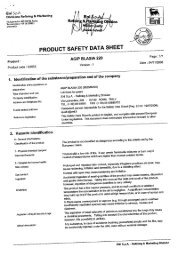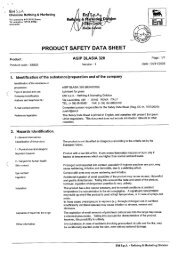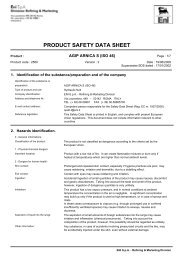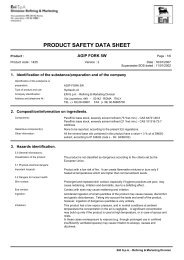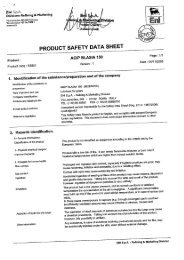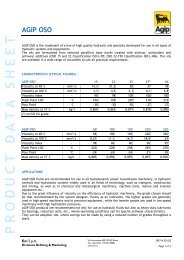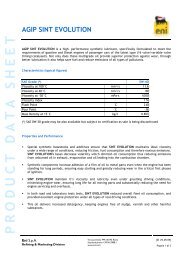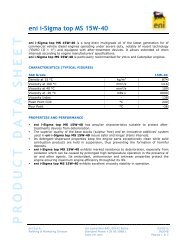AGIP FORMULA C2 (SAE 5W-30). - TransDiesel
AGIP FORMULA C2 (SAE 5W-30). - TransDiesel
AGIP FORMULA C2 (SAE 5W-30). - TransDiesel
Create successful ePaper yourself
Turn your PDF publications into a flip-book with our unique Google optimized e-Paper software.
PRODUCT SAFETY DATA SHEET<br />
Product :<br />
Product code : 7061<br />
<strong>AGIP</strong> <strong>FORMULA</strong> <strong>C2</strong> (<strong>SAE</strong> <strong>5W</strong>-<strong>30</strong>)<br />
Version : 1<br />
Page : 5/7<br />
Date : 20/10/2009<br />
10. Stability and reactivity.<br />
Thermal decomposition products:<br />
Stability:<br />
Hazardous reactions:<br />
Materials to avoid:<br />
HC, COx, NOx, SOx, H2S, POx<br />
Stable product.<br />
None<br />
Strong oxidants<br />
11. Toxicological information.<br />
Oral toxicity (rat):<br />
Dermal toxicity (rabbit):<br />
Inhalation toxicity (rat):<br />
Skin sensitization:<br />
Other information:<br />
LD50 greater than 2000 mg/kg (estimated from the composition)<br />
LD50 greater than 2000 mg/kg (estimated from the composition)<br />
LC50 greater than 5 mg/l/4h (estimated from the composition)<br />
Contains a sensitizer (calcium sulphonate) in an amount > 0.1 % wt (Ref.: Dir.<br />
1999/45/CE)<br />
The product is not classified as a sensitizer according to the criteria set by the EU.<br />
(Refers to active component).<br />
* Not irritating to eyes and skin<br />
* Minor irritation may occur after prolonged or repeated contact, especially if normal<br />
hygienic rules are not respected.<br />
* None of the components of this product are listed as carcinogen by NTP, IARC,<br />
OSHA, EU or others.<br />
12. Ecological information.<br />
General informations:<br />
Biodegradation:<br />
Toxicity for aquatic organisms:<br />
Other data:<br />
WGK class (Germany): 1<br />
Handle according to general working hygiene practices to avoid pollution and<br />
release into the environment.<br />
The most significant constituents of the product should be considered as "inherently<br />
biodegradable", but not "readily biodegradable", and they may be moderately<br />
persistent, particularly in anaerobic conditions.<br />
This product is not soluble in water. It floats on water and forms a film on the<br />
surface. The damage to aquatic organisms is of mechanical kind (immobilization and<br />
entrapment)<br />
No specific environmental data are available for this product.<br />
According to the components, and by comparison with other products of the same<br />
type and composition, it is expected that this product has a toxicity for aquatic<br />
organisms > 100 mg/l, and must not be regarded as dangerous to the environment.<br />
This product has no specific properties for inhibition of bacterial activity.<br />
In any case, wastewater containing this product should be treated in plants that are<br />
suited for the specific purpose.<br />
13. Disposal considerations.<br />
Disposal of product:<br />
European Waste Catalogue Code:<br />
Do not dispose of the product, either new or used, by discharging into sewers,<br />
tunnels, lakes or water courses. Deliver to a qualified official collector.<br />
13 02 05 (Ref: 2001/118/CE)<br />
This code is only a general indication, and takes into account the original composition<br />
ENI S.p.A. - Refining & Marketing Division



